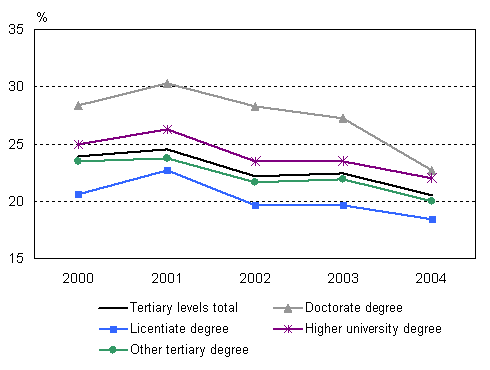This set of statistics has been discontinued.
New data are no longer produced from the statistics.
Published: 17 January 2007
Mobility of highly educated employees decreased in early 2000s
Altogether 20.5 per cent of highly educated employees changed jobs in 2004. The share was 2.5 percentage points lower than in 2000. The rate of mobility decreased most, from 28 to 23 per cent, among those with a degree at the doctorate level. Rates of mobility generally increase as the level of education rises, but an exception to this are persons with a licentiate level degree, among whom the rate of mobility was the lowest throughout the examined years. A highly educated person is here defined as someone with at least the lowest level of tertiary degree and mobility in this context refers to having changed jobs or become employed since the previous year.
Examined by economic activity, the rate of mobility was the highest in 2000 in the field of medical and health care sciences at 32 per cent, from where it fell to 26 per cent in 2004. The lowest rates of mobility were recorded in the fields of agriculture and forestry, in both of which the rate was approximately 19 per cent in 2004. Field of science was defined for doctorate and higher levels of university degrees. Mobility rates for other, lower levels of education fell from 24 to 20 per cent in 2004.
Mobility rates of highly educated employees by level of education in 2000-2004

The proportion of highly educated employees of all employed labour force grew by two percentage points from 2000 to 2004, when it reached 36 per cent. The share of highly educated employees was the highest, or 18 per cent, in human health activities.
One-third of the employees with a doctorate level degree worked in universities and approximately 16 per cent in human health activities. Around 29 per cent of the employees with a higher university degree worked in the field of education. One-fifth of the employees with some other tertiary level degree worked in human health activities.
Highly educated employees by economic activity and completed degree in 2004
| Economic activity | Share of labour force employed by activity % |
Doctorate level degree % |
Higher level university degree % |
Other tertiary level degree % |
Total % |
| Agriculture, forestry and fishery | 17,7 | 0,3 | 0,9 | 2,6 | 2,1 |
| Mining and quarrying | 18.4 | 0.0 | 0.1 | 0.1 | 0.1 |
| Food, textiles | 18.4 | 0.3 | 0.7 | 1.4 | 1.2 |
| Wood products, pulp, paper products | 27.1 | 2.5 | 3.9 | 4.5 | 4.3 |
| Metals, machinery and equipment | 28.1 | 2.4 | 4.3 | 6.2 | 5.6 |
| Computers, telecommunication equipment | 58.5 | 2.6 | 3.8 | 2.1 | 2.6 |
| Other manufacturing | 19.9 | 0.2 | 0.4 | 1.0 | 0.8 |
| Electricity, gas and water supply | 40.6 | 0.2 | 0.5 | 0.9 | 0.8 |
| Construction | 17.1 | 0.2 | 0.7 | 3.8 | 2.9 |
| Trade | 24.8 | 1.7 | 4.9 | 13.0 | 10.6 |
| Transport, communications | 17.1 | 0.3 | 1.4 | 4.0 | 3.2 |
| Telecommunications | 50.9 | 0.3 | 1.0 | 1.3 | 1.2 |
| Financial and insurance intermediation | 60.5 | 1.0 | 3.0 | 3.4 | 3.2 |
| Computer and related activities | 61.6 | 1.3 | 3.7 | 2.8 | 3.0 |
| Business services | 38.8 | 4.4 | 10.2 | 10.4 | 10.2 |
| Public sector research institutes | 70.6 | 8.0 | 1.8 | 0.5 | 1.0 |
| Other research | 67.4 | 1.7 | 0.5 | 0.1 | 0.3 |
| Universities | 73.6 | 33.7 | 5.1 | 0.8 | 2.8 |
| Other tertiary education | 81.9 | 3.9 | 1.5 | 0.3 | 0.7 |
| Other education | 70.3 | 7.2 | 22.2 | 6.5 | 10.7 |
| Human health activities | 44.7 | 15.9 | 12.0 | 20.6 | 18.2 |
| Public administration | 56.8 | 7.1 | 10.3 | 8.0 | 8.6 |
| Other economic activities | 33.2 | 3.3 | 5.7 | 4.3 | 4.6 |
| Activity unknown/missing | 25.3 | 1.6 | 1.4 | 1.3 | 1.3 |
| Economic activities, total | 35.9 | 100.0 | 100.0 | 100.0 | 100.0 |
Source: Human resources of science and technology. Statistics Finland
Inquiries: Markku Virtaharju +358 1734 3290, tiede.teknologia@stat.fi
Director in charge: Ms Kaija Hovi
- Tables
-
Tables in databases
Pick the data you need into tables, view the data as graphs, or download the data for your use.
Last updated 17.1.2007
Statistics:
Human resources of science and technology [e-publication].
ISSN=1797-3244. 2005. Helsinki: Statistics Finland [referred: 25.4.2024].
Access method: http://www.stat.fi/til/tthv/2005/tthv_2005_2007-01-17_tie_001_en.html

